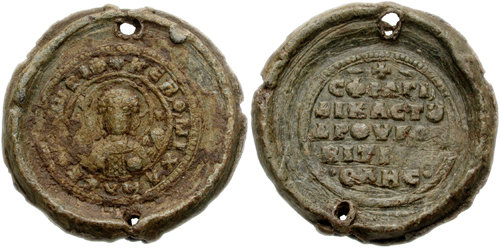Dregoviti on:
[Wikipedia]
[Google]
[Amazon]
The Drougoubitai, also Drogobitai or Dragobitai ( gr, О”ПҒОҝ …іОҝ …Ібҝ–П„ОұО№/О”ПҒОұОіОҝОІбҝ–П„ОұО№), variously anglicized as Drugubites, Drogubites, Druguvites, Draguvites etc., were a South Slavic group (''
 The 7th-century ''
The 7th-century ''
Sclaveni
The ' (in Latin) or ' (various forms in Greek, see below) were early Slavic tribes that raided, invaded and settled the Balkans in the Early Middle Ages and eventually became the progenitors of modern South Slavs. They were mentioned by early Byz ...
'') who settled in the Balkans
The Balkans ( ), also known as the Balkan Peninsula, is a geographical area in southeastern Europe with various geographical and historical definitions. The region takes its name from the Balkan Mountains that stretch throughout the who ...
in the 7th century. Two distinct branches are mentioned in the sources, one living in medieval Macedonia to the north and east of Thessalonica
Thessaloniki (; el, ОҳОөПғПғОұО»ОҝОҪОҜОәО·, , also known as Thessalonica (), Saloniki, or Salonica (), is the second-largest city in Greece, with over one million inhabitants in its metropolitan area, and the capital of the geographic region of ...
and around Veroia
Veria ( el, О’ОӯПҒОҝО№Оұ or О’ОӯПҒПҒОҝО№Оұ), officially transliterated Veroia, historically also spelled Berea or BerЕ“a, is a city in Central Macedonia, in the geographic region of Macedonia, northern Greece, capital of the regional unit of ...
(in modern Greece
Greece,, or , romanized: ', officially the Hellenic Republic, is a country in Southeast Europe. It is situated on the southern tip of the Balkans, and is located at the crossroads of Europe, Asia, and Africa. Greece shares land borders ...
).
History
 The 7th-century ''
The 7th-century ''Miracles of Saint Demetrius
The ''Miracles of Saint Demetrius'' ( la, Miracula Sancti Demetrii) is a 7th-century collection of homilies, written in Greek, accounting the miracles performed by the patron saint of Thessalonica, Saint Demetrius. It is a unique work for the ...
'', which chronicle the Slavic invasions and settlement in the Balkans
The Balkans ( ), also known as the Balkan Peninsula, is a geographical area in southeastern Europe with various geographical and historical definitions. The region takes its name from the Balkan Mountains that stretch throughout the who ...
, list the first branch of the Drougoubitai along with four other Sclaveni
The ' (in Latin) or ' (various forms in Greek, see below) were early Slavic tribes that raided, invaded and settled the Balkans in the Early Middle Ages and eventually became the progenitors of modern South Slavs. They were mentioned by early Byz ...
tribes living in the vicinity of Thessalonica
Thessaloniki (; el, ОҳОөПғПғОұО»ОҝОҪОҜОәО·, , also known as Thessalonica (), Saloniki, or Salonica (), is the second-largest city in Greece, with over one million inhabitants in its metropolitan area, and the capital of the geographic region of ...
. According to the ''Miracles'', they were led by kings, and were tributary allies to the Byzantines.Kazhdan (1991), p. 662 The ''Miracles'' also record their participation in two unsuccessful attacks by Sclaveni coalitions on Thessalonica, in 617/618 and 677
__NOTOC__
Year 677 ( DCLXXVII) was a common year starting on Thursday (link will display the full calendar) of the Julian calendar. The denomination 677 for this year has been used since the early medieval period, when the Anno Domini calendar e ...
.
By 879, a bishopric of Drougoubiteia (О”ПҒОҝП…ОіОҝП…ОІО№П„ОөОҜОұ), suffragan to the Metropolis of Thessalonica, had been established. Nicolas Oikonomides
Nikolaos or Nikos Oikonomides ( el, ОқО№ОәПҢО»ОұОҝПӮ ОҹО№ОәОҝОҪОҝОјОҜОҙО·ПӮ, 14 February 1934 вҖ“ 31 May 2000) was a Greek Byzantinist, and one of the leading experts in the field of Byzantine administration.
Biography
Oikonomides was born in ...
has suggested that at about the same time, the tribe was placed under a Byzantine military governor with the title of '' strategos''. In the late 10th and 11th centuries, Drougoubiteia is attested as being united with the themes of Thessalonica
Thessaloniki (; el, ОҳОөПғПғОұО»ОҝОҪОҜОәО·, , also known as Thessalonica (), Saloniki, or Salonica (), is the second-largest city in Greece, with over one million inhabitants in its metropolitan area, and the capital of the geographic region of ...
and Strymon into a single province.Kazhdan (1991), p. 663 In the early 10th century, John Kaminiates
John Kaminiates ( el, ОҷПүО¬ОҪОҪО·ПӮ ОҡОұОјО№ОҪО№О¬П„О·ПӮ, fl. tenth century) was a Greek resident of Thessalonica when the city, then one of the largest in the Byzantine Empire, was besieged and sacked by a Saracen force led by Leo of Tripoli in ...
speaks of the Drougoubitai as living around Veroia
Veria ( el, О’ОӯПҒОҝО№Оұ or О’ОӯПҒПҒОҝО№Оұ), officially transliterated Veroia, historically also spelled Berea or BerЕ“a, is a city in Central Macedonia, in the geographic region of Macedonia, northern Greece, capital of the regional unit of ...
, while in the 13th century, Demetrios Chomatenos Demetrios Chomatenos or Chomatianos ( el, О”О·ОјО®П„ПҒО№ОҝПӮ О§ПүОјОұП„О·ОҪПҢПӮ/О§ПүОјОұП„О№ОұОҪПҢПӮ, 13th century), Eastern Orthodox Archbishop of Ohrid from 1216 to 1236, was a Byzantine priest and judge.
His comprehensive legal education allowed ...
mentions them as "ruling" all the land from Veroia up to Skopje
Skopje ( , , ; mk, РЎРәРҫРҝСҳРө ; sq, Shkup) is the capital and List of cities in North Macedonia by population, largest city of North Macedonia. It is the country's political, cultural, economic, and academic centre.
The territory of Sk ...
.Nesbitt & Oikonomides (1991), p. 84
See also
*List of Medieval Slavic tribes
This is a list of Slavic peoples and Slavic tribes reported in Late Antiquity and in the Middle Ages, that is, before the year AD 1500.
Ancestors
*Proto-Indo-Europeans (Proto-Indo-European speakers)
** Proto-Balto-Slavs (common ancestors of Bal ...
References
Sources
* * * * * {{Slavic ethnic groups (VII-XII century) Byzantine Greece Medieval Macedonia Slavic tribes in Macedonia Slavic tribes in Thrace and Moesia Sclaveni